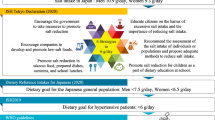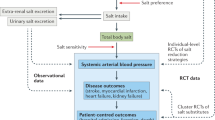Abstract
Hypertension is one of the major risk factors for cardiovascular disease, the prevention of which is acknowledged to be critically important. Human beings are the only animal species which consume large quantities of salt, and their consumption has increased with the advancement of civilization. Many observational and interventional epidemiologic studies have demonstrated that a high intake of salt results in elevation of blood pressure, and that a salt-reduced diet induces blood pressure reduction in patients with hypertension as well as in individuals with normal blood pressure. Reduced salt intake, blood pressure reduction, and a remarkable decrease in mortality due to stroke in Japan are important examples of this effect. A decrease in the mean blood pressure in an entire population can contribute significantly to decreased incidence of cardiovascular diseases. A population-based strategy for preventing hypertension, including a salt-reduced diet, is therefore desirable. Proposed measures include public health education by the mass media, reduced salt content in processed foods, salt reduction in foods served by schools or organizations and at restaurants, and labeling of salt content. Further studies are needed of population-wide salt reduction methods, and the effectiveness of such methods.
Similar content being viewed by others
References
Stamler J, Stamler R, Neaton JD. Blood pressure, systolic and diastolic, and cardiovascular risks: US population data. Arch. Intern. Med. 1993; 153: 598–615.
MacMahon S, Peto R, Cutler J, Collins R, Sorlie P, Neaton J, Abbott R, Godwin J, Dyer AR, Stamler J. Blood pressure, stroke, and coronary heart disease: part 1, prolonged differences in blood pressure: prospective observation studies corrected for the regression dilution bias. Lancet 1990; 335: 765–774.
Eastern Stroke and Coronary Heart Disease Collaborative Research Group. Blood pressure, cholesterol, and stroke in eastern Asia. Lancet 1998; 352: 1802–1807.
Guidelines Subcommittee. 1999 World Health Organization—International Society of Hypertension Guidelines for the management of hypertension. J. Hypertens. 1999; 17: 151–183.
Chobanian AV, Bakris GL, Black HR, Cushman WC, Green LA, Izzo JL Jr, Jones DW, Materson BJ, Oparil S, Wright JT, Jr, Roccella EJ, and the National High Blood Pressure Education Program Coodinating Committee. The seventh report of the Joint National Committee on Prevention, Detection, Evaluation, and Treatment of High Blood Pressure: the JNC 7 Report. JAMA 2003; 289: 2560–2572.
Guidelines Subcommittee of the Japanese Society of Hypertension. Japanese Society of Hypertension Guidelines for the management of hypertension (JSH 2000). Tokyo: The Japanese Society of Hypertension; 2000.
Welton PK, He J, Appel LJ, Cutler JA, Havas S, Kotchen TA, Roccella EJ, Stout R, Vallbona C, Winston MC, Karibakas J. Primary prevention of hypertension: clinical and public health advisory from the National High Blood Pressure Education Program. JAMA 2002; 288: 1882–1888.
National High Blood Pressure Education Program Working Group. National High Blood Pressure Education Program working group report on primary of hypertension. Arch. Intern. Med. 1993; 153: 186–208.
Pearson TA, Blair SN, Daniels SR, et al. AHA guidelines for primary prevention of cardiovascular disease and stroke: 2002 update. Consensus panel guide to comprehensive risk reduction for adult patients without coronary or other atherosclerotic vascular diseases. Circulation 2002; 106: 388–391.
Eaton SB, Konner M. Paleolithic nutrition. N. Engl. J. Med. 1985; 312: 283–288.
Takahashi E, Sasaki N, Takeda J, et al. The geographic distribution of cerebral hemorrhage and hypertension in Japan. Hum. Biol. 1957; 29: 139–166.
de Wardener HE, MacGregor GA. Sodium and blood pressure. Curr. Opin. Cardiol. 2002; 17: 360–367.
Dahl LK. Possible role of salt intake in the development of essential hypertension, in Cottier P, Bock KD (eds):Essential Hypertension—An International Symposium. Berlin, Springer-Verlag, 1960, pp 53–65.
Gleibermann L. Blood pressure and dietary salt in human populations. Ecology and Food Nutrition 1973; 2: 143–156.
Intersalt Cooperative Research Group. Intersalt: an international study of electrolyte excretion and blood pressure. Results for 24 hour urinary sodium and potassium excretion. BMJ 1988; 297: 319–328.
Rose G, Stamler J, on behalf of the INTERSALT Co-operative Research Group. The INTERSALT study: background, methods and main results. J. Hum. Hypertens. 1989; 3: 283–288.
Elliott P, Stamler J, Nichols R, Dyer AR, Stamler R, Kesteloot H, Marmot M, for the Intersalt Cooperative Research Group. Intersalt revisited: further analyses of 24 hour sodium excretion and blood pressure within and across populations. BMJ 1996; 312: 1249–1253.
Sakata K, Labarthe DR. Changes in cardiovascular disease risk factors in three Japanese National Surveys 1971–1990. J. Epidemiol. 1996; 6: 93–107.
Ministry of Health, Labour and Welfare. The 5th National Survey of Cardiovascular Diseases. Tokyo: Ministry of Health, Labour and Welfare, Japan; 2002.
Ueshima H, Tatara K, Asakura S, Okamoto M. Declining trends in blood pressure level and the prevalence of hypertension, and changes in related factors in Japan, 1956–1980. J. Chron. Dis. 1987; 40: 137–147.
Katanoda K, Matsumura Y. National Nutrition Survey in Japan: its methodological transition and current findings. J. Nutr. Sci. Vitaminol. 2002; 48: 423–432.
Sasaki N. The salt factor in apoplexy and hypertension: epidemiology studies in Japan. In Prophylactic Approach to Hypertensive Diseases. Edited by Yamori Y. New York: Raven Press; 1979: 467–474.
Takemori K, Mikami S, Yamamoto H, Kadohama H, Kudo N, Nihira S. Changes in sodium and potassium excretions in the whole Japan and twelve regions over 15 years. JJCDP 2002; 37: 190–195 (in Japanese).
Cutler JA, Follmann D, Allender PS. Randomized trials of sodium reduction: an overview. Am. J. Clin. Nutr. 1997; 65: (suppl): 643S-651S.
He FJ, MacGregor GA. Effect of modest salt reduction on blood pressure: a meta-analysis of randomized trials. Implications for public health. J. Hum. Hypertens. 2002; 16: 761–770.
Midgley JP, Matthew AG, Greenwood CMT, Logan AG. Effect of reduced dietary sodium on blood pressure: a meta-analysis of randomized controlled trials. JAMA 1996; 275: 1590–1597.
Hooper L, Bartlett C, Smith GD, Ebrahim S. Systematic review of long term effects of advice to reduce dietary salt in adults. BMJ 2002; 325: 628–636.
The Trials of Hypertension Prevention Collaborative Research Group. The effects of nonpharmacologic interventions on blood pressure of persons with high normal levels: results of TOHP, phase I. JAMA 1992; 267: 1213–1220.
The Trials of Hypertension Prevention Collaborative Research Group. Effects of weight loss and sodium reduction intervention on blood pressure and hypertension incidence in over-weight people with high normal blood pressure: the Trials of Hypertension Prevention, Phase II. Arch. Intern. Med. 1997; 157: 657–667.
Whelton PK, Appel LJ, Espeland MA, et al. Sodium reduction and weight loss in the treatment of hypertension in older persons: a randomized controlled trial of nonpharmacologic interventions in the elderly (TONE). JAMA 1998; 279: 839–846.
Appel LJ, Espeland MA, Easter L, Wilson AC, Folmar S, Lacy CR. Effects of reduced sodium intake on hypertension control in older individuals: results from the Trial of Nonpharmacologic Interventions in the Elderly (TONE). Arch. Intern. Med. 2001; 161: 685–693.
Appel LJ, Moore TJ, Obarzanek E, et al. A clinical trial of the effects of dietary patterns on blood pressure. N. Engl. J. Med. 1997; 336: 1117–1124.
Conlin PR, Chow D, Miller ER III, et al. The effect of dietary pattern on blood pressure control in hypentensive patients: results from Dietary Approach to Stop Hypertension (DASH) trials. Am. J. Hypertens. 2000; 13: 949–955.
Sacks FM, Svetkey LP, Vollmer WM, et al. Effects on blood pressure of reduced dietary sodium and the dietary approach to stop hypertension (DASH) diet. N. Engl. J. Med. 2001; 344: 3–10.
Chobanian AV, Hill M, National Heart, Lung, and Blood Institute Workshop on sodium and blood pressure: a critical review of current scientific evidence. Hypertension 2000; 35: 858–863.
Alderman MH, Cohen H, Madhaven S. Dietary sodium intake and mortality: the National Health and Nutrition Examination Survey (NHANES I). Lancet 1998; 351: 781–785.
Tuomilehto J, Jousilahti P, Rastenyte D, Moltchanov V, Tanskanen A, Pietinen P, Nissinen A. Urinary sodium excretion and cardiovascular mortality in Finland: a prospective study. Lancet 2001; 357: 848–851.
He J, Ogden LG, Vupputuri S, Bazzano LA, Loria C, Welton PK. Dietary sodium intake and subsequent risk of cardiovascular disease in overweight adults. JAMA 1999; 282: 2027–2034.
Rose G. The Strategy of Preventive Medicine. New York, NY: Oxford University Press; 1992.
Rose G. Sick individuals and sick populations. Int. J. Epidemiol. 1985; 14: 32–38.
Stamler J, Rose G, Stamler R, Elliott P, Dyer AR, Marmot M. INTERSALT study findings: public health and medical care implications. Hypertension 1989; 14: 570–577.
Cook AR, Cohen J, Hebert PR, Taylor JO, Hennekens CH. Implications of small reduction in diastolic blood pressure for primary prevention. Arch. Intern. Med. 1995; 155: 701–709.
Murray CJL, Lauer JA, Hutubessy RCW, Niessen L, Tomijima N, Rodgers A, Lawes CMM, Evans DB. Effectiveness and costs of interventions to lower systolic blood pressure and cholesterol: a global and regional analysis on reduction of cardiovascular-disease risk. Lancet 2003; 361: 717–725.
Staessen J, Bulpitt CJ, Fagard R, Joossens JV, Lijnen P, Amery A. Salt intake and blood pressure in the general population: a controlled intervention trial in two towns. J. Hypertens. 1988; 6: 965–973.
Forte JG, Miguel JM, Miguel MJ, de Padua F, Rose G. Salt and blood pressure: a community trial. J. Hum. Hypertens 1989; 3: 179–184.
Tian HG, Guo ZY, Hu G, Yu SJ, Sun W, Pietinen P, Nissinen A. Changes in sodium intake and blood pressure in a community-based intervention project in China. J. Hum. Hypertens. 1995; 9: 959–968.
Fortmann SP, Varady AN. Effects of a community-wide health education program on cardiovascular disease morbidity and morality: the Stanford Five-City Project. Am. J. Epidemiol. 2000; 152: 316–323.
Vartiainen E, Puska P, Jousilahti P, Korhonen HJ. Cardiovascular diseases and risk factors in Finland. Prev. Med. 1999; 29: S124–129.
D'Atri DA, Fitzgerald EF, Freeman JH, Jr, Vitale JN, Ostefeld AM. The Connecticut High Blood Pressure Program: a program of public education and high blood pressure screening. Prev. Med. 1980; 9: 91–107.
Crawford D. Population strategies to prevent obesity: only few studies attempted so far and with limited success. BMJ 2002; 325: 728–729.
Okamura T, Tanaka T, Babazono A, Yoshit K, Chiba N, Takebayashi T, Nakagawa H, Yamato H, Miura K, Tamaki J, Kadowaki T, Okayama A, Ueshima H, for the HIPOP-OHP research group. The High-risk and Population Strategy for Occupational Health Promotion (HIPOP-OHP) Study: study design and cardiovascular risk factors at the baseline survey. J. Hum. Hypertens. 2004; (in press).
Okamura T, Tanaka T, Takebayashi T. Methodological issue for a large scale intervention trial by lifestyle modification: the HIPOP Study. Environ. Health Prev. Med. 2004; 9: 137–143.
Yoshita K, Takana T, Miura K, Kikuchi Y. The evaluation of materials to provide health-related information as a population strategy in the worksite: the High-risk and Population Strategy for Occupational Health Promotion (HIPOP-OHP) Study. Environ. Health Prev. Med. 2004; 9: 144–151.
Author information
Authors and Affiliations
Corresponding author
Rights and permissions
About this article
Cite this article
Nakagawa, H., Miura, K. Salt reduction in a population for the prevention of hypertension. Environ Health Prev Med 9, 123–129 (2004). https://doi.org/10.1007/BF02898090
Received:
Accepted:
Issue Date:
DOI: https://doi.org/10.1007/BF02898090




